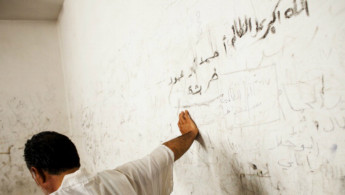Notorious Palmyra prison forgotten amid celebrations of regime 'victory'
News of Palmyra's recapture by Syrian regime forces was met with some public acclaim, particularly among western archaeologists and antiquities experts in view of IS militants wanton destruction of the UNESCO heritage site.
However, opposition activists strongly criticised one-sided celebrations particularly in view of one of Palmyra's most notorious sites - the Tadmur prison.
Following the weekends recapture of Palmyra, users on social media were eager to highlight the infamous role of the prison in the history of opposition to the Assad regime.
Attested to have held more than 20,000 Syrian political prisoners between 1980 and 1990, and hundreds in the decades thereafter, the Tadmor prison gained unique notoriety among Syrian opposition activists for its inhumane conditions and the widespread use of torture and execution by the Syrian regime.
A 2001 report by Amnesty International said "Tadmur Prison is commonly referred to in Syria today as a place where 'the person who enters is lost, and the one who leaves is born'."
"The prison gained this notorious reputation on account of the persistent reports over many years of systematic torture and ill-treatment," it added.
While reported to have been shut in 2001, the Tadmur prison continued to be subject of reports of illegal detention of opposition members.
Most notoriously, it is reported to have been site of a mass executions of over 600 Muslim Brotherhood opposition members in 1980, in the immediate aftermath of a failed assassination attempt against then Syrian president Hafez al-Assad.
Twitter Post
|
Twitter Post
|
Meanwhile, Syrian regime soldiers and Islamic State [IS] group militants engaged in heavy fighting in central Syria on Tuesday, two days after the militant group was pushed out of the ancient city of Palmyra.
Regime forces and pro-government militias, backed by Russian airstrikes, advanced towards the IS-held town of al-Qaryatain south-west of Palmyra, according to the Syrian Observatory for Human Rights.
All parties were involved in violent clashes with causalities from both sides reported, the UK-based observatory said.
IS militants captured the strategic town of al-Qaryatain in August last year, kidnapping at least 230 people, including dozens of Christians, and razing its famed 1,500 year old Mar Elian monastery.
Tuesday's advances in al-Qaryatain will help secure a "final victory" over the militant group, Syrian defence minister Fahed Jassem al-Freij claimed.





 Follow the Middle East's top stories in English at The New Arab on Google News
Follow the Middle East's top stories in English at The New Arab on Google News
![Netanyahu furiously denounced the ICC [Getty]](/sites/default/files/styles/image_330x185/public/2024-11/GettyImages-2169352575.jpg?h=199d8c1f&itok=-vRiruf5)
![Both Hamas and the Palestinian Authority welcomed the ICC arrest warrants [Getty]](/sites/default/files/styles/image_330x185/public/2024-11/GettyImages-2178351173.jpg?h=199d8c1f&itok=TV858iVg)
